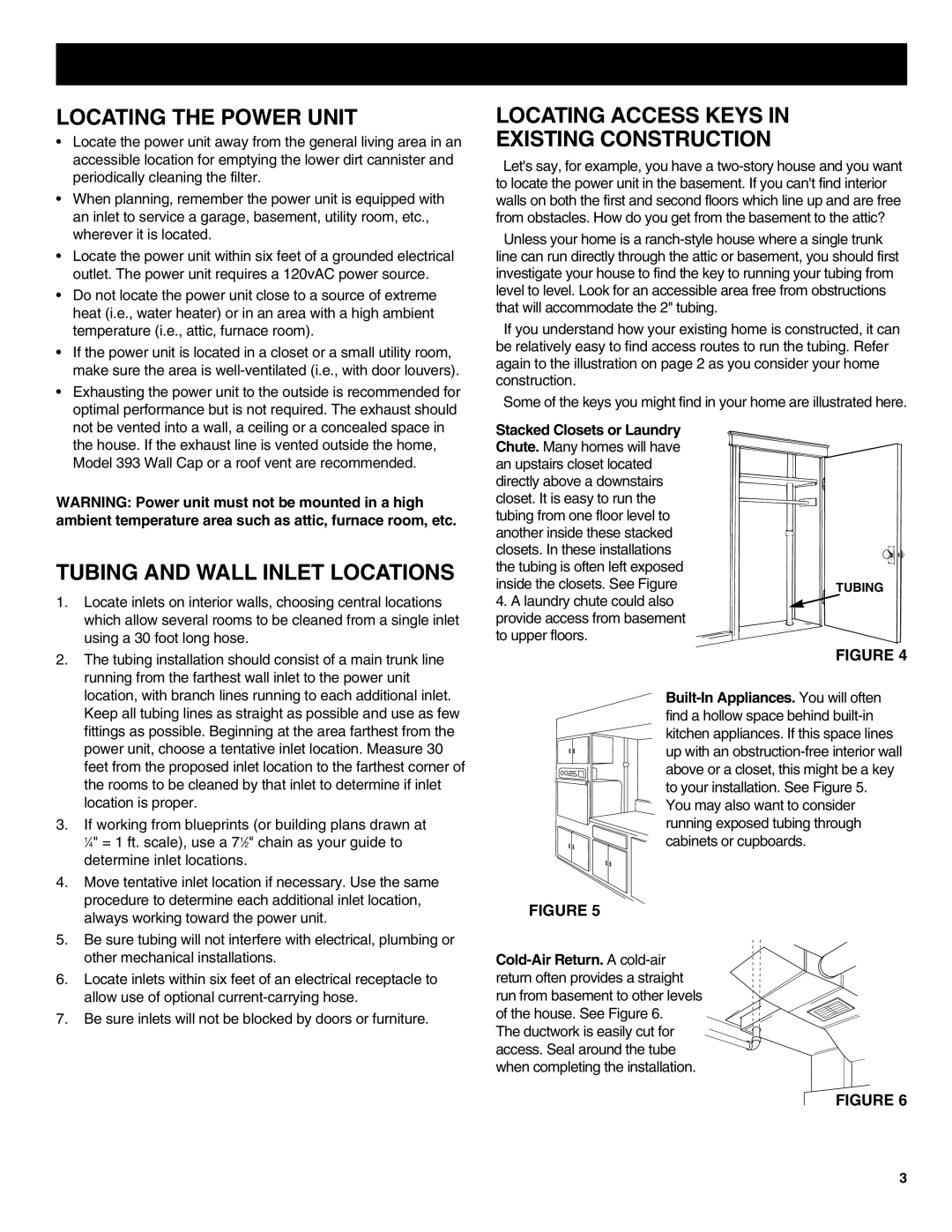
LOCATING THE POWER UNIT
•Locate the power unit away from the general living area in an accessible location for emptying the lower dirt cannister and periodically cleaning the filter.
•When planning, remember the power unit is equipped with an inlet to service a garage, basement, utility room, etc., wherever it is located.
•Locate the power unit within six feet of a grounded electrical outlet. The power unit requires a 120vAC power source.
•Do not locate the power unit close to a source of extreme heat (i.e., water heater) or in an area with a high ambient temperature (i.e., attic, furnace room).
•If the power unit is located in a closet or a small utility room, make sure the area is
•Exhausting the power unit to the outside is recommended for optimal performance but is not required. The exhaust should not be vented into a wall, a ceiling or a concealed space in the house. If the exhaust line is vented outside the home, Model 393 Wall Cap or a roof vent are recommended.
WARNING: Power unit must not be mounted in a high ambient temperature area such as attic, furnace room, etc.
TUBING AND WALL INLET LOCATIONS
1.Locate inlets on interior walls, choosing central locations which allow several rooms to be cleaned from a single inlet using a 30 foot long hose.
2.The tubing installation should consist of a main trunk line running from the farthest wall inlet to the power unit location, with branch lines running to each additional inlet. Keep all tubing lines as straight as possible and use as few fittings as possible. Beginning at the area farthest from the power unit, choose a tentative inlet location. Measure 30 feet from the proposed inlet location to the farthest corner of the rooms to be cleaned by that inlet to determine if inlet location is proper.
3.If working from blueprints (or building plans drawn at
1⁄4" = 1 ft. scale), use a 71⁄2" chain as your guide to determine inlet locations.
4.Move tentative inlet location if necessary. Use the same procedure to determine each additional inlet location, always working toward the power unit.
5.Be sure tubing will not interfere with electrical, plumbing or other mechanical installations.
6.Locate inlets within six feet of an electrical receptacle to allow use of optional
7.Be sure inlets will not be blocked by doors or furniture.
LOCATING ACCESS KEYS IN
EXISTING CONSTRUCTION
Let's say, for example, you have a
Unless your home is a
If you understand how your existing home is constructed, it can be relatively easy to find access routes to run the tubing. Refer again to the illustration on page 2 as you consider your home construction.
Some of the keys you might find in your home are illustrated here.
Stacked Closets or Laundry |
|
Chute. Many homes will have |
|
an upstairs closet located |
|
directly above a downstairs |
|
closet. It is easy to run the |
|
tubing from one floor level to |
|
another inside these stacked |
|
closets. In these installations |
|
the tubing is often left exposed |
|
inside the closets. See Figure | TUBING |
4. A laundry chute could also |
|
provide access from basement |
|
to upper floors. |
|
FIGURE 4
You may also want to consider running exposed tubing through cabinets or cupboards.
FIGURE 5
The ductwork is easily cut for access. Seal around the tube when completing the installation.
FIGURE 6
3
